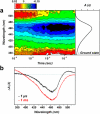Combined probes of X-ray scattering and optical spectroscopy reveal how global conformational change is temporally and spatially linked to local structural perturbation in photoactive yellow protein
- PMID: 26960811
- PMCID: PMC4809902
- DOI: 10.1039/c6cp00476h
Combined probes of X-ray scattering and optical spectroscopy reveal how global conformational change is temporally and spatially linked to local structural perturbation in photoactive yellow protein
Abstract
Real-time probing of structural transitions of a photoactive protein is challenging owing to the lack of a universal time-resolved technique that can probe the changes in both global conformation and light-absorbing chromophores of the protein. In this work, we combine time-resolved X-ray solution scattering (TRXSS) and transient absorption (TA) spectroscopy to investigate how the global conformational changes involved in the photoinduced signal transduction of photoactive yellow protein (PYP) is temporally and spatially related to the local structural change around the light-absorbing chromophore. In particular, we examine the role of internal proton transfer in developing a signaling state of PYP by employing its E46Q mutant (E46Q-PYP), where the internal proton transfer is inhibited by the replacement of a proton donor. The comparison of TRXSS and TA spectroscopy data directly reveals that the global conformational change of the protein, which is probed by TRXSS, is temporally delayed by tens of microseconds from the local structural change of the chromophore, which is probed by TA spectroscopy. The molecular shape of the signaling state reconstructed from the TRXSS curves directly visualizes the three-dimensional conformations of protein intermediates and reveals that the smaller structural change in E46Q-PYP than in wild-type PYP suggested by previous studies is manifested in terms of much smaller protrusion, confirming that the signaling state of E46Q-PYP is only partially developed compared with that of wild-type PYP. This finding provides direct evidence of how the environmental change in the vicinity of the chromophore alters the conformational change of the entire protein matrix.
Figures




References
-
- Schotte F, Lim MH, Jackson TA, Smirnov AV, Soman J, Olson JS, Phillips GN, Wulff M, Anfinrud PA. Science. 2003;300:1944–1947. - PubMed
-
- Chen EF, Kumita JR, Woolley GA, Kliger DS. J. Am. Chem. Soc. 2003;125:12443–12449. - PubMed
-
- Lewis JW, Goldbeck RA, Kliger DS, Xie XL, Dunn RC, Simon JD. J. Phys. Chem. 1992;96:5243–5254.
Publication types
MeSH terms
Substances
Grants and funding
LinkOut - more resources
Full Text Sources
Other Literature Sources
Miscellaneous

